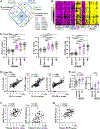Mechanisms and biomarkers of inflammatory endotypes in chronic rhinosinusitis without nasal polyps
- PMID: 33326802
- PMCID: PMC8216505
- DOI: 10.1016/j.jaci.2020.11.037
Mechanisms and biomarkers of inflammatory endotypes in chronic rhinosinusitis without nasal polyps
Abstract
Background: Chronic rhinosinusitis (CRS) without nasal polyps (CRSsNP) is a common disease that is characterized by multiple inflammatory endotypes. However, the molecular mechanisms in CRSsNP are poorly understood compared with those of polypoid CRS.
Objective: Our aim was to identify mechanisms and biomarkers associated with inflammatory endotypes underpinning CRSsNP.
Methods: Ethmoid tissues and nasal lavage fluids (NLFs) were obtained from control patients and patients with CRS. The gene expression profiles were determined by microarray analysis and quantitative RT-PCR, and expression of proteins was measured by ELISA and Luminex analysis.
Results: Microarray found that compared with their levels of expression in control tissue, the levels of expression of 126, 241, and 545 genes were more than 3-fold and significantly elevated in CRSsNP with type 1 (T1) endotype, type 2 (T2) endotype, and type 3 (T3) endotype, respectively. Selected identified genes were confirmed by RT-PCR. Gene set enrichment analysis suggested that T1 CRSsNP was associated with IFN-γ signaling and antiviral immunity controlled by T cells (TH1 and CD8+), natural killer cells, and antigen-presenting cells; T2 CRSsNP was associated with STAT6 signaling and IgE-mediated activation controlled by eosinophils, mast cells, TH2 cells, group 2 innate lymphoid cells, and antigen-presenting cells; and T3 CRSsNP was associated with IL-17 signaling, acute inflammatory response, complement-mediated inflammation, and infection controlled by neutrophils, TH17 cells, B cells, and antigen-presenting cells. The results suggest that T1 (CXCL9 and CXCL10), T2 (eosinophilic proteins and CCL26), and T3 (CSF3) endotypic biomarkers in NLF may be able to distinguish tissue endotypes in CRSsNP.
Conclusions: Inflammatory endotypes in CRSsNP were controlled by different molecular mechanisms. NLF biomarker assays may allow for more precise and personalized medical treatments in CRS.
Keywords: Chronic rhinosinusitis without nasal polyps; biomarker; endotype; transcriptome.
Copyright © 2020 American Academy of Allergy, Asthma & Immunology. Published by Elsevier Inc. All rights reserved.
Conflict of interest statement
Figures




Similar articles
-
Associations Between Inflammatory Endotypes and Clinical Presentations in Chronic Rhinosinusitis.J Allergy Clin Immunol Pract. 2019 Nov-Dec;7(8):2812-2820.e3. doi: 10.1016/j.jaip.2019.05.009. Epub 2019 May 22. J Allergy Clin Immunol Pract. 2019. PMID: 31128376 Free PMC article.
-
JESREC score and mucosal eosinophilia can predict endotypes of chronic rhinosinusitis with nasal polyps.Auris Nasus Larynx. 2019 Jun;46(3):374-383. doi: 10.1016/j.anl.2018.09.004. Epub 2018 Sep 19. Auris Nasus Larynx. 2019. PMID: 30243753
-
Effects of anti-inflammatory drugs on distinct endotypes of chronic rhinosinusitis without nasal polyps: comparison using an ex-vivo model.Eur Rev Med Pharmacol Sci. 2024 Oct;28(20):4477-4489. doi: 10.26355/eurrev_202410_36872. Eur Rev Med Pharmacol Sci. 2024. PMID: 39497591
-
The current findings in eosinophilic chronic rhinosinusitis.Auris Nasus Larynx. 2024 Feb;51(1):51-60. doi: 10.1016/j.anl.2023.08.002. Epub 2023 Aug 11. Auris Nasus Larynx. 2024. PMID: 37574421 Review.
-
[Different immunological types of CRSwNP in the context of the new European EAACI nomenclature : Part 1: Hypersensitivity reactions of type IVa-c as a correlate to T1, T2, and T3 endotypes].HNO. 2025 Jul;73(7):474-482. doi: 10.1007/s00106-025-01600-9. Epub 2025 Apr 8. HNO. 2025. PMID: 40198352 Free PMC article. Review. German.
Cited by
-
Targeting Epithelium Dysfunction and Impaired Nasal Biofilms to Treat Immunological, Functional, and Structural Abnormalities of Chronic Rhinosinusitis.Int J Mol Sci. 2023 Aug 3;24(15):12379. doi: 10.3390/ijms241512379. Int J Mol Sci. 2023. PMID: 37569753 Free PMC article. Review.
-
Suppressor of Cytokine Signaling Proteins 3 and 5 Potentially Delineate Polarization of Th cells in Chronic Rhinosinusitis.Yale J Biol Med. 2024 Jun 28;97(2):165-177. doi: 10.59249/HZFN2950. eCollection 2024 Jun. Yale J Biol Med. 2024. PMID: 38947108 Free PMC article.
-
IL-13 and IL-13-induced periostin levels are specifically decreased in patients following endoscopic sinus surgery for chronic rhinosinusitis.J Allergy Clin Immunol. 2024 May;153(5):1292-1305. doi: 10.1016/j.jaci.2023.11.922. Epub 2023 Dec 28. J Allergy Clin Immunol. 2024. PMID: 38157944 Free PMC article.
-
Transcriptomic Differentiation of Phenotypes in Chronic Rhinosinusitis and Its Implications for Understanding the Underlying Mechanisms.Int J Mol Sci. 2023 Mar 14;24(6):5541. doi: 10.3390/ijms24065541. Int J Mol Sci. 2023. PMID: 36982612 Free PMC article.
-
Role of Fibroblasts in Chronic Inflammatory Signalling in Chronic Rhinosinusitis with Nasal Polyps-A Systematic Review.J Clin Med. 2023 May 4;12(9):3280. doi: 10.3390/jcm12093280. J Clin Med. 2023. PMID: 37176721 Free PMC article. Review.
References
-
- Fokkens WJ, Lund VJ, Mullol J, Bachert C, Alobid I, Baroody F, et al. European Position Paper on Rhinosinusitis and Nasal Polyps 2012. Rhinol Suppl 2012; 23:3 p preceding table of contents, 1–298. - PubMed
-
- Orlandi RR, Kingdom TT, Hwang PH, Smith TL, Alt JA, Baroody FM, et al. International Consensus Statement on Allergy and Rhinology: Rhinosinusitis. Int Forum Allergy Rhinol 2016; 6 Suppl 1:S22–209. - PubMed
-
- Smith KA, Orlandi RR, Rudmik L. Cost of adult chronic rhinosinusitis: A systematic review. Laryngoscope 2015; 125:1547–56. - PubMed
-
- Tomassen P, Vandeplas G, Van Zele T, Cardell LO, Arebro J, Olze H, et al. Inflammatory endotypes of chronic rhinosinusitis based on cluster analysis of biomarkers. J Allergy Clin Immunol 2016; 137:1449–56 e4. - PubMed
Publication types
MeSH terms
Substances
Grants and funding
LinkOut - more resources
Full Text Sources
Medical
Research Materials
Miscellaneous

